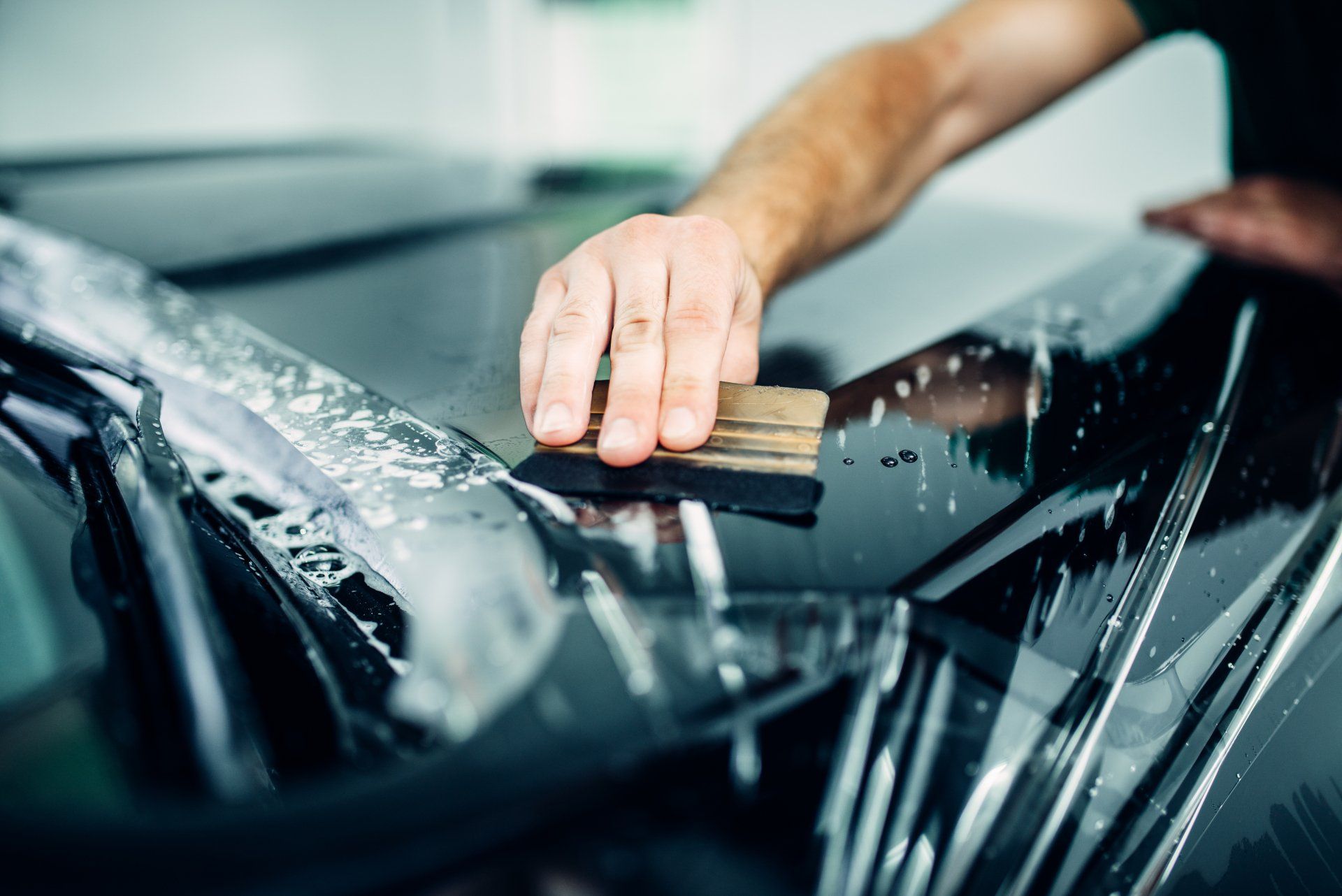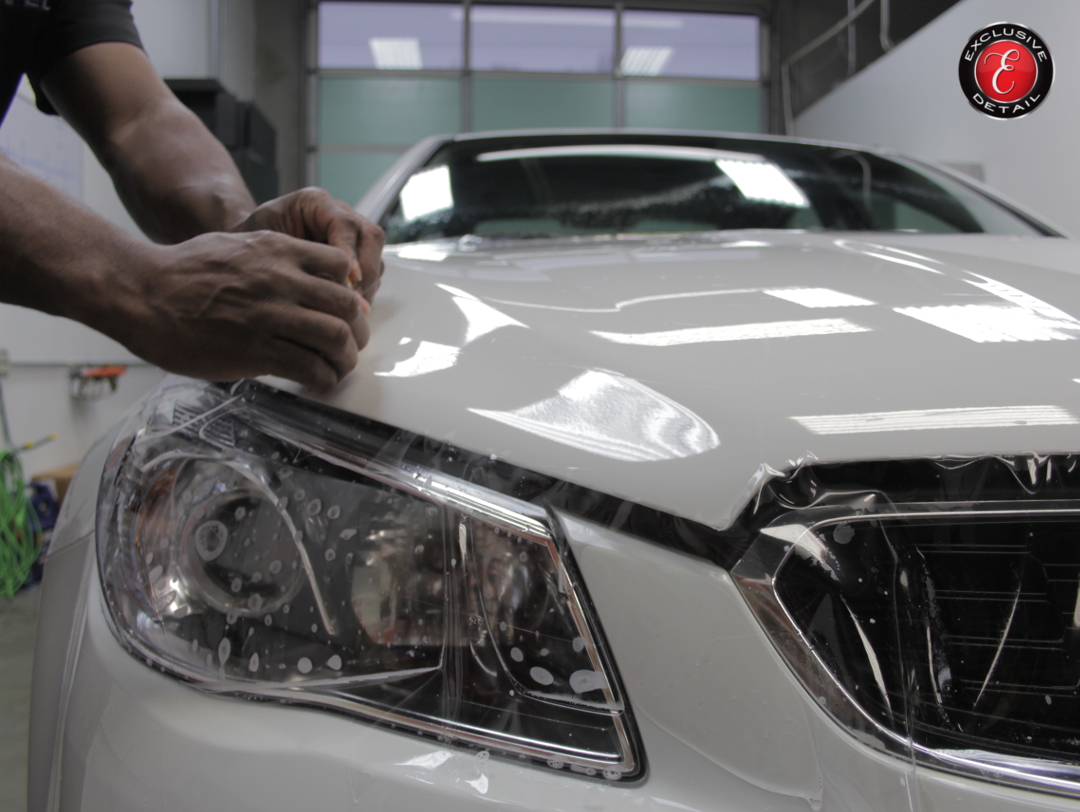The Ultimate Overview to Comprehending Paint Protection Film for Cars And Truck Lovers
Paint Protection Film (PPF) has come to be a crucial topic among auto enthusiasts looking for to preserve their vehicle's look. This innovative protective layer supplies many benefits, from securing against ecological dangers to preserving resale worth. Understanding the various types of PPF, the application procedure, and maintenance pointers can substantially impact one's financial investment. Yet, numerous misunderstandings linger. What are the most typical misconceptions, and how do they contrast to various other protective choices?
What Is Paint Protection Film (PPF)?
Paint Protection Film (PPF) offers as a transparent shield for automobile surface areas. This innovative polyurethane material is developed to stick flawlessly to a vehicle's exterior, offering a safety layer versus numerous ecological hazards. PPF is typically related to high-impact locations, such as hoods, bumpers, and mirrors, where scrapes and chips are most likely to occur.The film is incredibly long lasting, offering resistance versus UV rays, roadway particles, and chemical spots, which can deteriorate a lorry's coating with time. Its self-healing properties permit small scratches to go away with heat exposure, maintaining an immaculate appearance. PPF is available in various finishes, including gloss and matte, to match different paint designs and preferences.Installation requires precision, commonly best done by experts to assure a perfect application. Generally, Paint Protection Film is a cutting-edge option for auto fanatics looking for to protect their automobile's visual charm while shielding its surface area stability.
Benefits of Using Paint Protection Film
While numerous automobile fanatics prioritize appearances, the practical advantages of Paint Protection Film (PPF) are just as engaging. PPF functions as a durable barrier versus numerous ecological threats, consisting of roadway particles, rock chips, and insect discolorations, efficiently preserving the vehicle's outside. Furthermore, it offers UV defense, protecting against paint from fading and keeping the auto's lively shade over time.Another considerable advantage is the self-healing properties of innovative PPFs, which can recover from minor scrapes and swirl marks with warm exposure, making sure the finish continues to be excellent. Setup of PPF can also boost resale value; prospective buyers are usually drawn in to well-maintained automobiles without any noticeable flaws. Moreover, PPF is easy to tidy and requires very little upkeep, allowing auto fanatics to enjoy their automobiles without the anxiety of continuous upkeep. Overall, PPF integrates performance with aesthetic appeals, making it a sensible financial investment for car enthusiasts.
Different Types of Paint Protection Film
Comprehending the different kinds of paint protection film is essential for vehicle enthusiasts. Key functions such as self-healing modern technology, comparisons of density and resilience, and application techniques play an essential duty in selecting the right choice. Each type offers distinctive benefits that accommodate different demands and choices.
Self-Healing Innovation Explained
Self-healing technology revolutionizes the means auto lovers safeguard their cars from square one and minor damage. This ingenious feature is primarily located in sophisticated paint security films (PPF) When exposed to heat from sunlight or a warm atmosphere, the one-of-a-kind polymers within these movies soften, permitting tiny scrapes and swirl marks to "recover" themselves. This self-repairing ability not only keeps the movie's visual allure but likewise extends its safety top qualities. Various brands offer various formulas of self-healing films, each with distinctive attributes tailored to specific demands. Cars and truck enthusiasts value this innovation for its ability to maintain their cars looking pristine, lowering the frequency of repairs and making sure a longer-lasting protective solution versus day-to-day deterioration.

Density and Toughness Comparison
Density and resilience are critical aspects when assessing various kinds of paint security film (PPF) PPF commonly varies in density from 6 mils to 12 mils, with thicker films supplying improved resistance to scrapes, chips, and environmental damages. Thinner movies, while less safety, frequently give much better clearness and conformability, making them suitable for intricate layouts and curves. Toughness varies among brand names and types; some films include advanced products that enhance their life expectancy and keep their look over time. In addition, self-healing homes in certain PPF kinds can better expand durability by permitting minor scratches to disappear with warmth. Eventually, the choice of density and resilience ought to line up with the particular requirements and preferences of the cars and truck lover.
Application Methods Introduction
Selecting the best application method is vital for making best use of the advantages of paint security film (PPF) There are various methods readily available, each matched to various choices and skill levels. The most usual strategies consist of the standard wet application, which utilizes a slip solution to facilitate positioning, and the dry application, which calls for accuracy and experience for instant bond. Furthermore, advanced choices like pre-cut packages supply ease, developed to fit details lorry versions, while mass movie enables personalization yet demands extra experience (SpeedEFX Paint Protection Film). Each technique provides special advantages and challenges, making it visit this web-site essential for car fanatics to pick one that lines up with their goals and capabilities, inevitably making certain suitable defense for their cars
The Application Process of PPF
The application procedure of paint security film (PPF) involves several vital steps to assure perfect outcomes. Initially, extensive surface prep work is necessary, complied with by specific installment strategies that maximize attachment and protection. Appropriate post-application care is essential to maintain the movie's stability and look over time.
Surface Area Prep Work Tips
Appropriate surface area preparation is crucial for a successful paint security movie (PPF) application, as it directly affects the movie's attachment and longevity. The initial step involves extensively cleaning the automobile to get rid of dust, crud, and various other impurities. A pH-neutral vehicle soap is suggested to prevent damaging the paint. Complying with the laundry, the surface ought to be dried meticulously with microfiber towels to stop water spots. Next, any existing imperfections, such as scrapes or swirls, have to be addressed, typically using a gloss or substance. Ultimately, the surface area should be wiped down with an isopropyl alcohol solution to guarantee it is entirely tidy and devoid of oils or residues. This precise preparation lays the structure for a successful PPF installation.
Installment Methods Discussed
Understanding the application procedure of paint security film (PPF) is vital for attaining the finest results. The installment typically starts with accurate measurements of the lorry's surfaces to guarantee correct protection. Tidiness is paramount; the surface area needs to be without dust, dirt, and pollutants. An installer commonly makes use of a slip remedy, which helps with positioning the film during application.The movie is meticulously laid onto the surface, utilizing tools like mops to eliminate air bubbles and excess solution. Heat might be put on adapt the film to complex contours and shapes. Appropriate alignment and tension are crucial for a smooth finish. Ultimately, trimming excess movie guarantees a tidy side, completing the installment process effectively and boosting the vehicle's visual appeals and defense.
Post-Application Care Tips

Upkeep Tips for Long-Lasting Protection
How can automobile enthusiasts guarantee their paint defense movie continues to be effective over time? Routine maintenance is important to protect the film's long life and efficiency (SpeedEFX Paint Protection Film). To start with, cleaning the lorry with a pH-balanced auto hair shampoo aids protect against the build-up of impurities that can harm the movie. Utilizing a why not check here microfiber cloth for drying is advised to prevent scratches.Additionally, it is crucial to stay clear of rough cleaning tools or severe chemicals, which can break down the movie's surface. Applying a sealer or wax especially developed for paint protection movie can offer an added layer of defense versus UV rays and ecological elements.Furthermore, enthusiasts need to consistently examine the movie for any type of signs of wear or damages, resolving problems quickly to keep its protective top qualities. Vehicle parking in shaded areas or utilizing car covers can additionally minimize exposure to hazardous UV rays. By adhering to these maintenance pointers, automobile fanatics can guarantee their paint security movie stays effective for years
Usual Myths About Paint Protection Film
What mistaken beliefs surround paint security film that car fanatics should be aware of? One common misconception is that paint protection film (PPF) makes a vehicle look unsightly or yellow with time. In reality, premium PPF is made to continue to be clear and maintain its appearance. Another common belief is that PPF is only essential for brand-new cars; nevertheless, any car can benefit from this protective layer, despite age. Some enthusiasts also think that PPF is too expensive; while it may require an upfront investment, the long-term savings on paint repairs can offset first prices. In addition, several think that PPF is a do it yourself job, but professional installation guarantees correct placement and attachment, optimizing performance. Lastly, there is a mistaken belief that PPF is not long lasting, yet improvements in innovation have made modern-day movies resistant to scratches, discolorations, and UV damages, supplying trusted protection for years.
Contrasting PPF to Other Protection Options
Understanding the numerous choices available for vehicle defense is very important for vehicle enthusiasts that wish to keep their car's look. Paint Protection Film (PPF) is commonly compared to wax, ceramic coatings, and traditional sealers. While wax supplies a short-term luster and basic defense, it commonly needs constant reapplication and uses minimal longevity. Ceramic coverings give boosted protection versus UV rays and chemical spots, yet they can be much more costly and require expert application.PPF attracts attention because of its durable protection versus physical damages, such as scratches and rock chips. Unlike wax or sealers, PPF is a resilient service that can endure rough problems without weakening. In addition, PPF can self-heal from minor abrasions, maintaining its clearness and safety high qualities. Overall, while each alternative has advantages, PPF is commonly favored for its unparalleled security and resilience, making it a perfect selection for severe cars and truck enthusiasts.
Frequently Asked Concerns
How Much Time Does Paint Protection Film Last on a Car?
The durability of paint defense movie on a lorry usually ranges from 5 to 10 years, depending upon variables such as ecological problems, upkeep practices, and the quality of the movie used throughout application.
Can PPF Be Gotten Rid Of Without Damaging the Car's Paint?
The elimination of paint defense movie (PPF) can be done very carefully, frequently without harming the lorry's paint. SpeedEFX Paint Protection Film. The procedure calls for appropriate strategies and devices to assure the underlying surface remains undamaged and undamaged.
Is PPF Installation a Do It Yourself Project or Ideal Left to Professionals?
The question of whether paint security film (PPF) setup is ideal for DIY lovers or ideal handled by specialists typically develops. Many experts recommend expert installation to ensure suitable adherence and stay clear of possible damages during the procedure.
Does Paint Protection Film Influence the Car's Resale Worth?
The effect of paint protection film on an automobile's resale value differs. While it can boost appearance and secure against damage, potential purchasers might have mixed feelings, valuing the movie differently based on their preferences and experiences.
Can PPF Be Applied Over Existing Scrapes or Chips?
Applying paint protection movie (PPF) over existing scrapes or chips is typically not recommended. Imperfections may worsen in time, and appropriate surface prep work is essential for perfect attachment and long life of the film's protective qualities.